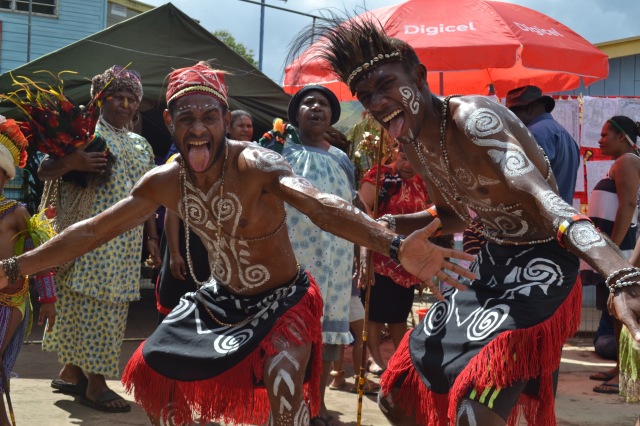The youth and houseline handcrafts and enjoys traditional dance in the village, afterward, a ball is thrown into the mix and free play is now the focus of the day. Social influence working at its best to promote motor skills, strength, speed, and endurance is an often overlooked component of physical development and sports.
Was dance the warm-up activity? Did dance affect the intensity at which the ball game was played? Did the intensity of the game affect the level of fun at which the game was played?

Following our participation through an exhibition 100m sprint event at the 2018 Goroka Show, the question of continued partnership with the promotion and tourism authority has led to further analysis. As we dissect the individual benefits of cultural dance, performances at tourism events, school participation and social promotion; the question of universality and sports development lies. Conditioning activities can enhance performance through physiological mechanisms linked to increased muscle temperature; decreased muscle stiffness, increased oxygen delivery in muscles. Increases in heart rates can be seen in Papua New Guinea cultural dance participants through planned movements that involve running, jumping, arm lengthening and moderate to loud speech. The physical requirements for nonpracticing populations may cause a different physiological response than those who frequent the activity. Dancers need high levels of strength and balance for a variety of reasons; for example, slow and controlled movements require the dancer to support the weight if the leg through their range of motion for several seconds.
Psychological benefits derive from dance as well; According to the American Association of Homes and Services for the Aging, dance is universally enjoyable and beneficial; few people consider it exercise. Despite this, segmental benefits exist; activities such as belly dance supports the maintenance of a strong abdomen, an erect spine and steady sense of inner balance. Qualitative studies have shown aesthetic forms of expression build passion and can contribute to older adults physical, intellectual, and social development and self-motivation. This research invites the questions like what would happen if more tourism opportunities were provided in Papua New Guinea; and how would this affect the older population. A related study on dance utilized measurements in cardiovascular endurance, flexibility, muscular strength, balance, cognitive ability, and body composition. This study showed a significant improvement of 60-90 percent in at least one of the measures of physical health and no evidence in the negative direction.
The IAAF has set a model for youth development following general physical education principles which set out to improve cardiovascular endurance, flexibility, muscular strength, balance, cognitive ability, speed, and agility. Though not confined to schools and school children, the social structure of schools is an ideal environment to implement such principles to benefit the general population and aspiring athletes. School through youth interaction serves as a site where bodily norms are disseminated in multiple interconnecting ways that shape how youths understand bodies and bodily practices. With the benefits from continuous play and body awareness duly stated, there may be a benefit for tourism performers as it related to movement (speed, fluency), endurance and diaphragm activation for greater tourist entertainment.
Well conditioned athletes who perform under stressful or highly observed conditions contribute to the medal tally in National pride events such as Pacific Games, Oceania Championships and Olympic Games. With sports psychology being noted as a necessary component to high performance, opportunities to perform in stimulating environments both sport and nonsport related should increase with tourism opportunities in the country.
Dior Lowry
Videos
Major activity at 2:30 seconds
Brown, Andrea C., et al. “Effects of Plyometric Training Versus Traditional Weight Training on Strength, Power, and Aesthetic Jumping Ability in Female Collegiate Dancers.” Journal of Dance Medicine & Science, vol. 11, no. 2, May 2007, pp. 38–44. EBSCOhost, 0-search.ebscohost.com.library.ecok.edu/login.aspx?direct=true&db=s3h&AN=25527473&site=eds-live&scope=site.
“Dance Your Problems Away.” Industrial Engineer: IE, vol. 46, no. 3, Mar. 2014, p. 14. EBSCOhost, 0-search.ebscohost.com.library.ecok.edu/login.aspx?direct=true&db=bth&AN=94510160&site=eds-live&scope=site.
Ferreira-Júnior, João B., et al. “Effects of Different Conditioning Activities on 100-m Dash Performance in High School Track and Field Athletes.” Perceptual And Motor Skills, vol. 125, no. 3, June 2018, pp. 566–580. EBSCOhost, doi:10.1177/0031512518764494.
Hubiak, Brandi. “Belly Dancing: The Sacred Art (and Workout!).” New Life Journal: Carolina Edition, vol. 7, no. 1, Feb. 2006, pp. 12–30. EBSCOhost, 0-search.ebscohost.com.library.ecok.edu/login.aspxdirect=true&db=hxh&AN=19957695&site=eds-live&scope=site.
Hwang, Phoebe Woei-Ni, and Kathryn L. Braun. “The Effectiveness of Dance Interventions to Improve Older Adults’ Health: A Systematic Literature Review.” Alternative Therapies In Health And Medicine, vol. 21, no. 5, Sept. 2015, pp. 64–70. EBSCOhost, 0-search.ebscohost.com.library.ecok.edu/login.aspx?direct=true&db=mnh&AN=26393993&site=eds-live&scope=site.
Jette, Shannon, and Erica Blue Roberts. “‘We Usually Just Start Dancing Our Indian Dances’: Urban American Indian ( AI) Female Youths’ Negotiation of Identity, Health and the Body.” Sociology of Health & Illness, vol. 38, no. 3, Mar. 2016, pp. 396–410. EBSCOhost, doi:10.1111/1467-9566.12349.
“Retraction: Dance Reveals Symmetry Especially in Young Men.” Nature, vol. 504, no. 7480, Dec. 2013, p. 470. EBSCOhost, doi:10.1038/nature12728.
